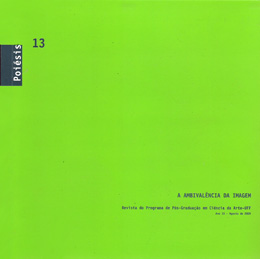O perfil de movimento de Kestenberg: categorias de análise e aplicação preliminar em dança
DOI:
https://doi.org/10.22409/poiesis.1013.135-144Palavras-chave:
análise de movimento, ritmo, coreografiaResumo
Este artigo apresenta o método prioritariamente terapêutico denominado Kestenberg Movement Profile (KMP), desenvolvido por Dra. Judith Kestenberg - psiquiatra e discípula de Rudolf Laban -, para aplicação preliminar na análise rítmica comparativa de duas obras coreográficas, estabelecendo uma relação inédita entre KMP e dança.Downloads
Referências
Allison, Nancy, org. (1999). The Illustrated Enciclopedia of Body-Mind Disciplines. New York: The Rosen
Publishing Group.
Amighi, J. K.; Loman, S.; Lewis, P.; e Sossin, K. M. (1999). The Meaning of Movement, Developmental and
Clinical Perspectives of the Kestenberg Movement Profile. New York: Routledge Publishers.
Barba, Eugenio e Savarese, Nicola (1995). A Arte Secreta do Ator. Dicionário de Antropologia Teatral. São Paulo:
HUCITEC.
Bartenieff, Irmgard (1980). Body movement: Coping with the environment. Langhorne: Gordon and Breach.
Cohen, Bonnie Bainbridge (1993). Sensing, Feeling, and Action. The Experiential Anatomy of Body-Mind
Centering. Northampton: Contact Editions.
Cohen, Renato (1998). Work in Progress na Cena Contemporânea. Criação, Encenação, Recepção. São Paulo:
Perspectiva.
Fernandes, Ciane (2006). O Corpo em Movimento: O Sistema Laban/Bartenieff na Formação e Pesquisa em
Artes Cênicas. São Paulo: Annablume. 2ª Edição.
Hackney, Peggy (1998). Making Connections. Total Body Integration Through Bartenieff Fundamentals.
Amsterdam: Gordon and Breach Publishers.
Kestenberg, Judith S. (1975). Children and Parents. New York: Jason Aronson.
__________ (1965a): The role of movement patterns in development: 1. Rhythms of movement. Psychoanalytic
Quarterly, n.34: 1-36.
__________ (1965b). The role of movement patterns in development: 2. Flow of tension and effort. Psychoanalytic
Quarterly, n.34: 517-563.
__________ (1977). The Role of Movement Patterns in Development. Vol. I. New York: Dance Notation Bureau.
Kestenberg, Judith S.; Sossin, K. Mark (1979). The Role of Movement Patterns in Development. Vol.II. New
York: Dance Notation Bureau.
Laban. Rudolf (1920). Die Welt des Tänzers. Stuttgart: W. Seifert.
__________ (1976). The Language of Movement. A Guidebook to Choreutics. Lisa Ullmann, ed. Boston: Plays Inc.
LABAN, Rudolf e LAWRENCE, F. C. (1974). Effort. Economy of Human Movement. Estover, Plymouth:
Macdonald & Evans.
LAMB, Warren (1963). Posture and Gesture: An Introduction to the Study of Physical Behaviour. Londres:
Gerald Duckworth.
Lepecki, André (2005). Desfazendo a fantasia do sujeito (dançante): ‘Still acts’ em The Last Performance de
Jérôme Bel. In Lições de Dança n.5: 11-26.
Maletic, Vera (1987). Body - Space - Expression. The Development of Rudolf Laban’s Movement and Dance
Concepts. Berlin: Mounton de Gruyter.
Pallaro, Patricia, org. (1998) Authentic Movement: Essays by Mary Whitehouse, Janet Adler, and Joan
Chodorow. Volume I. Londres: Jessica Kingsley Publishers.
Prince, Robert (2006). Judith Kestenberg. In The Sphinx. A Forum for Inquiry and Innovation in Psychoanalysis.
Section V. Continuing Education. http://www.sectionfive.org/continuing_education/kestenberg/. Division of
Psychoanalysis. Consultado em 29.01.2008.
Downloads
Publicado
Edição
Seção
Licença
Autores(as) que publicam na Revista Poiésis concordam com os seguintes termos:
- Os(as) autores(as) mantêm os direitos autorais e concedem à revista o direito de primeira publicação. O trabalho é automaticamente licenciado sob a Licença Creative Commons Attribution, o que permite o seu compartilhamento desde que seja feito o reconhecimento da autoria e da publicação inicial nesta revista.
- Os(as) autores(as) têm permissão e são estimulados a distribuir online seu trabalho publicado na Revista Poiésis (em repositórios institucionais ou em sua própria página pessoal), uma vez que isso pode gerar interações produtivas, bem como aumentar o impacto e a citação do trabalho publicado (Veja O Efeito do Acesso Livre).


